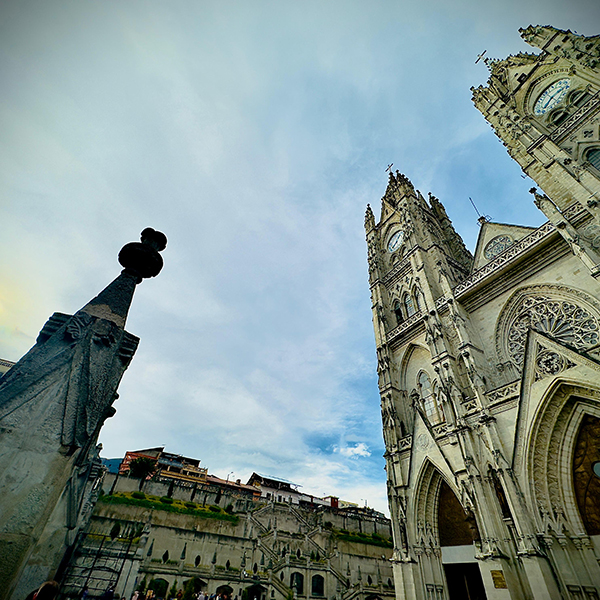
Having exited the cathedral, we are standing in the central plaza that is the atrium.
Let us now face the cathedral’s central façade, keying in on the heart-shaped window above.
From the window, look up to see the two 80 meter towers which majestically announce the cathedral.
The towers are connected by a gothic archivolt around which is an array of intricate bas-relief molding.
Now face the main doors to the cathedral. Atop a central pillar stands a bronze statue of Pope John Paul II. Above this, notice the rose window and the tympanum which is a semicircular ornament with the Star of David.
Now please turn your attention to the bronze statues on the façade of the cathedral.
In being unfinished, the front and side façades have space for a total of 230 statues commemorating saints and important Ecuadorian dignitaries past, present and future.
Presently, the statues are, from left to right, of:
Brother St. Miguel, Monsignor José Ignacio Ordóñez, Monsignor José Ignacio Checa y Barba, President Gabriel García Moreno, Pope John Paul II, President Luis Cordero, Monsignor Leonidas Proaño, Father Julio Matovelle, and Saint Mariana de Jesus.
Now, let us explore some of the cathedral’s unique architectural features. Please move to the left of the cathedral towards the plaza where there is a café and a gift shop.
Unlike Gothic cathedrals in Europe, the Basílica del Voto Nacional incorporates features unique to Ecuador.
Among these features are the gargoyles and acroteria.
The gargoyles are found primarily around the chapel of the Sacred Heart of Mary while acroteria of decorative pedestals and sculptures are situated throughout the upper, outer edge of the chancel.
These unique features represent Ecuador’s unique interpretation of neo-Gothic architecture, depicting both traditional mythological creatures and fauna native to Ecuador.
Look closely and you will spot figures of Galapagos tortoises, blue-footed boobies, frigate birds, armadillos, howler monkeys, pumas, and caimans.
Atop these animal figures are circular decorations engraved with the coats of arms of Latin American countries which symbolize the cathedral’s significance in matters of the nation’s foreign affairs.
In total, the Basílica del Voto Nacional has seven doors: three on the main façade, two on the east side, and two on the west side.
Originally, these seven doors signified the seven provinces of Ecuador extant at the time of the cathedral’s construction. Now, they represent the seven sacraments of the Catholic Church.
Presently, the doors are made of bronze made in Pietrasanta, Italy which were imported in the 1980s and 1990s. Each door is adorned with reliefs depicting scenes from the life of Jesus.
In line with the unique Ecuadorian features of this cathedral, one scene also depicts the baptism of the Inca emperor Atahualpa. This symbolizes the historical moment during Spanish colonial rule when Christianity was forcibly introduced to the indigenous people.
In addition to the bronze doors, the cathedral also features decorative wooden doors in a pointed arch style, a feature common to French gothic architecture.
Now, with the cathedral on your right, let us head to the plaza on your left. There you will see stairs descending towards the center of the plaza.
Please pause the audio until you reach these stairs.
This is the entrance to the crypt of the National Pantheon of Ecuador. Here, beneath the cathedral, is the resting place of numerous former presidents of Ecuador. It is open for public viewing only on weekends.
Presently, the following presidents are interred here:
Antonio Flores Gijón (1833–1915)
Andrés Fernández Córdoba Nieto (1892–1983)
Mariano Suárez Beintimilla (1897–1980)
Camilo Ponce Enriquez (1912–1976)
The crypt contains 50 tombs of French marble; and 139 urns each with a bronze plaque bearing the Ecuadorian coat of arms.
At the center of the crypt’s façade stands the “Resurrected Christ” by noted Ecuadorian sculptor, America Salazar. This sculpture is flanked by two bronze condors which also serve as ceremonial platforms.
Now, from the bottom of the stairs, look to the north and east. You will see the cathedral’s spire also known as the condor tower.
If you would like to climb the spire and clock tower, please head back to the cathedral’s south entrance. The ticket booth is located near the entrance. There you can also find an information desk and observation deck located nearby.
From atop the spire and clock tower, you may enjoy panoramic views of Quito as well as a close-up of the stained glass windows seen earlier from inside the cathedral.
The entrances to the towers are located on either side of the ticket booth.



